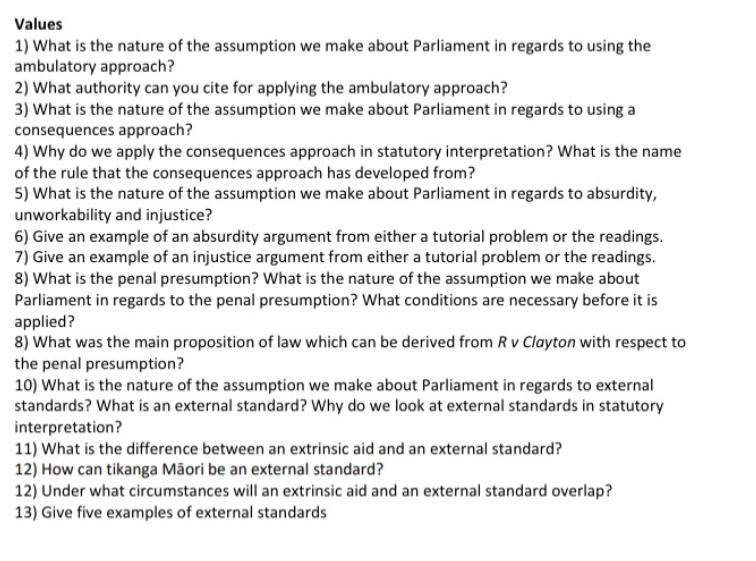Answered step by step
Verified Expert Solution
Question
1 Approved Answer
3) What is the mischief rule? (Can you think of a case that applied this in your course materials?) 4) How is the purposive


3) What is the mischief rule? (Can you think of a case that applied this in your course materials?) 4) How is the purposive approach similar and/or different from the literal approach and the mischief rule? 5) What authority can you cite for applying the purposive approach? 6) What are some of the advantages of applying the purposive approach? 7) What are some of the limitations of applying the purposive approach? 8) What are intrinsic and extrinsic aids? Why do we use them? How are they different? Give examples of each. 9) Can marginal notes be helpful in determining the purpose of the statute? 10) What is Hansard? How is Hansard useful? What are the limitations in using Hansard to determine the purpose of the statute? 11) Is the purpose section always relevant in determining the purpose of the statute with respect to the distinction? 12) Does it matter if you refer to an extrinsic aid as an external aid? 13) What is the starting point in constructing a purpose argument? Should you identify specific evidence in formulating your purpose arguments? 14) Does the purpose of individual provisions matter? 15) How do we use the facts in constructing purpose arguments? Is it an open licence to make purely factual arguments? 16) What authority can you cite for applying the purposive approach? Values 1) What is the nature of the assumption we make about Parliament in regards to using the ambulatory approach? 2) What authority can you cite for applying the ambulatory approach? 3) What is the nature of the assumption we make about Parliament in regards to using a consequences approach? 4) Why do we apply the consequences approach in statutory interpretation? What is the name of the rule that the consequences approach has developed from? 5) What is the nature of the assumption we make about Parliament in regards to absurdity, unworkability and injustice? 6) Give an example of an absurdity argument from either a tutorial problem or the readings. 7) Give an example of an injustice argument from either a tutorial problem or the readings. 8) What is the penal presumption? What is the nature of the assumption we make about Parliament in regards to the penal presumption? What conditions are necessary before it is applied? 8) What was the main proposition of law which can be derived from R v Clayton with respect to the penal presumption? 10) What is the nature of the assumption we make about Parliament in regards to external standards? What is an external standard? Why do we look at external standards in statutory interpretation? 11) What is the difference between an extrinsic aid and an external standard? 12) How can tikanga Mori be an external standard? 12) Under what circumstances will an extrinsic aid and an external standard overlap? 13) Give five examples of external standards
Step by Step Solution
There are 3 Steps involved in it
Step: 1
Answer Lets address each question Statutory Interpretation Purposive Approach 3 The mischief rule is a principle of statutory interpretation where the court looks at the mischief or defect that the st...
Get Instant Access to Expert-Tailored Solutions
See step-by-step solutions with expert insights and AI powered tools for academic success
Step: 2

Step: 3

Ace Your Homework with AI
Get the answers you need in no time with our AI-driven, step-by-step assistance
Get Started


